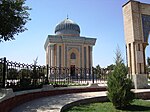Muhammad Sadik Muhammad Yusuf
This article includes a list of general references, but it lacks sufficient corresponding inline citations. (April 2017) |
Muhammad Sadik Muhammad Yusuf | |
|---|---|
| Muhammad Sodiq Muhammad Yusuf | |
 | |
| Born | 15 April 1952 (21 Rajab 1371 BH) |
| Died | March 10, 2015 (aged 62) Tashkent, Uzbekistan |
| Nationality | Uzbek |
| Education | Mir-i Arab madrassa |
| Scientific career | |
| Institutions | Spiritual Administration of the Muslims of Central Asia and Kazakhstan |
Muhammad Sadik Muhammad Yusuf (15 April 1952 - 10 March 2015) was an Uzbek Muslim scholar born in the region of Andijan.
Life
[edit]
Muhammad Sadik was the son of Muhammad-Yusuf (who died in 2004), who was the son of Muhammad-Ali, a scholar from Andijan.[1] He was the mufti of the Spiritual Administration of the Muslims of Central Asia and Kazakhstan. He was Uzbekistan’s first mufti after independence.[2]
Muhammad Sadik was a member of the International Union of Muslim Scholars (IUMS), a non-governmental organization of Islamic scholars.[3]
Biography
[edit]Muhammad Sadik received his primary religious education from his father. After finishing middle school in 1970, he attended the Mir-i Arab madrassa in Bukhara.[citation needed]
Muhammad Sadik then studied at the Tashkent Islamic Institute in Tashkent, finishing with distinction in 1975. He then edited the journal, Muslims of the east of the Soviet Union.[citation needed]
In 1976, Muhammad Sadik was admitted to ad-Dawa al-Islami National Islamic University in Libya, which he finished with distinction and a financial award. This period of study exposed him to a future generation of Muslim imams, mostly from the Arabic world but even reaching to places as far away as Japan.
Muhammad Sadik was elected mufti by the SADUM in March 1989, and in the same year he was elected as a deputy to the Supreme Soviet of the USSR. Sheikh presented a report to the former Soviet Union President Mikhail Gorbachev explaining the problems of Muslims rights in the protocol. He asked to return Muslims their rights to pray, to learn the religion.
In Muhammad Sadik's meeting with Gorbachev, positive changes have been seen in the policy towards the religion in the communist regime. With Muhammad Sodiq’s efforts, numerous mosques and madrassas were built in the Soviet Union. The Muslims were allowed to follow their religious traditions and ceremonies.[4]
In 1997 Muhammad Sadik was put in charge of Muslim countries and federations of the Commonwealth of Independent States within Rabita al-Alam al-Islami (Muslim World League), an international Islamic organization in Saudi Arabia. He was a permanent member of the governing council of this organization.[citation needed]
Death
[edit]Muhammad Sadik died on 10 March 2015 after suffering a heart attack.[5][6][7]
Writings
[edit]From 1994 to 2000, Muhammad Sadik published approximately thirty popular articles and twenty-five books and pamphlets. Most were written in Uzbek, and some were translated into Russian.[8] The main publisher was the Kara Su branch of the press of the Islamic cultural center in Osh.[citation needed]
Muhammad Sadik's books include: Tafsiri Hilal (Translation and interpretation of the meanings of the Glorious Qur'an, in 6 volumes), Hadith wa Hayot (Hadith and life, series of books talking about the history and all details of Islam systematically in details, history of all prophets.., around in 40 volumes.), Ruhiy tarbiya (Spiritual attitude development/education, 3 volumes), Kifoya (books on fiqh (Islamic law) 3 volumes), and many other books, booklets, audio and video materials in Islam and translations of Imaam Al Buhariy's famous books into Uzbek language.
In his books since 2002, Muhammad Sadik included the following credo at the beginning, in the style of an Islamic movement that is seeking to transcend the divisions within the faith:
Our motto: We aspire toward a true faith, toward a pure Islam, we desire to study the Qur'an and Sunna in order to follow them, and we want to spread the study of Islam. We want to follow the true mujtahids—the blessed ancestors (as-Salaf as-Salihun); we want to spread toleration and brotherhood (of Muslims). We also want to eradicate religious illiteracy and to put a stop to our contradictions and splits, to purge our fanaticism, and our sinful affairs.[9]
References
[edit]- ^ "A Face of Islam - Muhammad Sodiq Muhammad Yusuf" (PDF).
- ^ Moscow, USSR - December 21, 1990: Portrait of Uzbekistan's first mufti people's deputy Sheikh Muhammad Sadik Muhammad Yusuf at 4th Congress of People's Deputies of the USSR alamy.com
- ^ "Islamic Cultural Movements - Biographies". SSRC. Archived from the original on 2012-04-26. Retrieved 2010-12-20.
- ^ "Biography of Sheikh Muhammad Sodiq Muhammad Yusuf" (in Uzbek). Archived from the original on 2015-03-04. Retrieved 2015-03-14.
- ^ "Shayx Muhammad Sodiq Muhammad Yusuf janozasiga o'n minglab odam yig'ildi". Озодлик Радиоси. 12 March 2015.
- ^ "Muhammad Sodiq Muhammad Yusuf Toshkentda dafn etildi". amerikaovozi.com. 12 March 2015.
- ^ "Shayx Muhammad Sodiq Muhammad Yusuf". mirarab.uz.
- ^ Книги Шейха Мухаммада Садыка Перевели На Несколько Языков darakchi.uz
- ^ Olcott, Martha Brill (2012). In the Whirlwind of Jihad. Washington, D.C.: Brookings Institution Press. p. 125. ISBN 9780870033018.
- 1952 births
- 2015 deaths
- 20th-century Muslim scholars of Islam
- People from Andijan Region
- Hanafis
- Maturidis
- Grand Muftis of Uzbekistan
- Soviet muftis
- Translators of the Quran into Uzbek
- Members of the Congress of People's Deputies of the Soviet Union
- Members of the Supreme Soviet of the Soviet Union
- Quran translators

